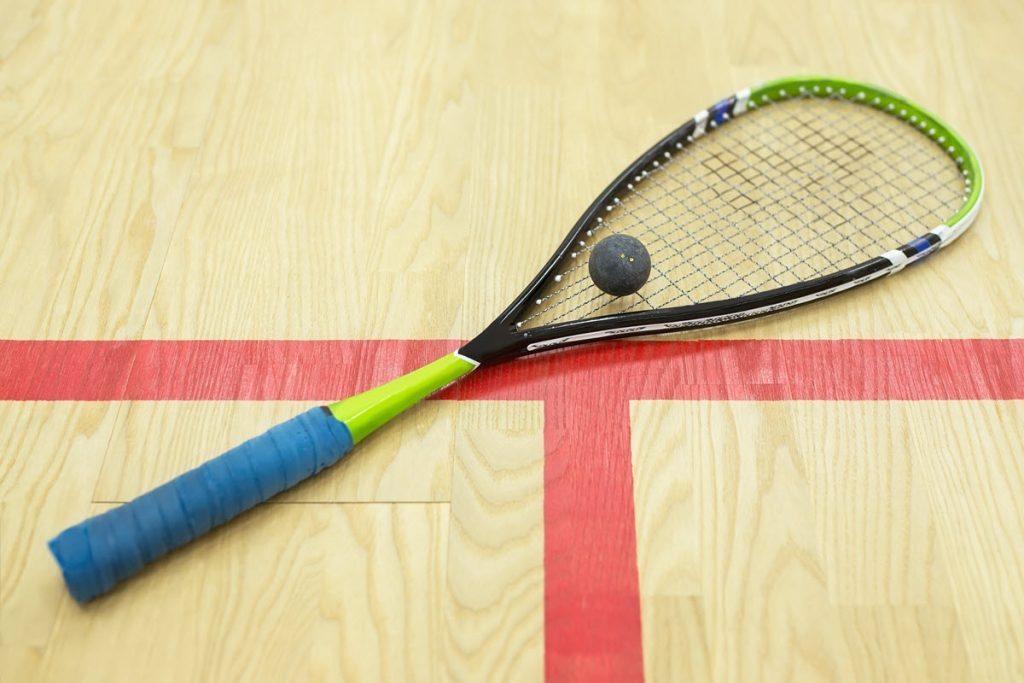Squash rackets may bear a similarity to those used in other sports like tennis and badminton, however a seasoned squash player will instinctively know which is the piece of equipment designed for their sport.
In this article, we’ll take a look at what makes a squash racket…. well – a squash racket!

What Is The Standard Squash Racket Shape?
Rackets differ from other sports like tennis mainly in their head. The shaft which separates the grip from the head is less important, however weight is important, which we’ll get to shortly.
The shape of the head of the squash racket tends to be one of two varieties. Beginners usually use a standard oval head, whereas more advanced players tend to prefer a teardrop shaped alternative.
Oval headed rackets usually have a greater area to hit the ball, requiring less accuracy to make it to the ball and strike it, whereas teardrop heads mean more accuracy and skill is required to make the shot, but tend to allow more control in power and direction of the ball after playing the shot due to more flexibility in striking it.
How Does Weight Affect Rackets?
To give a simple explanation, heavier rackets provide more power, and lighter rackets allow for more shot precision.
The heavier the racket, the more effort is needed to strike the ball. However, that weight provides more momentum in the swing, and in turn transfers more momentum to the ball as it is played. As professional players tend to be fitter and stronger than beginners and novices, they tend to prefer lighter rackets, as what they lose in power from the racket they can usually compensate for, while at the same time gaining more control and flexibility over the shots available to play.
There are guidelines which dictate the acceptable weight of a racket, with the World Squash Federation defining the maximum weight allowed as 255 grams.
Can You Use A Tennis Racket?
While theoretically you could hit the ball and play squash with a tennis racket, they’re not allowed under squash regulations, and almost certainly would be frowned upon if you took one onto your local court to play.
Squash rackets are allowed a maximum length of 686 millimeters, that’s 68.6 centimeters. In terms of width, they’re limit to a maximum dimension of 215 millimeters, that’s 21.5 centimeters.
As a result, a standard tennis racket is larger than the allowed size for squash.
What Are Squash Strings Made From?
Racket strings are made from synthetic materials like nylon. Strings for squash rackets are thinner than those in tennis, so you cannot restring your squash racket with them. Tennis strings would not be suitable as they would not provide sufficient momentum after hitting the ball, giving too little power in squash.
Professional squash players, like tennis players, are very specific about the strings they use and the tension they’re strung at in their rackets. Players who like to deliver a lot of power in their shots tend to opt for looser tensions, whereas the opposite goes for precision players who go for tighter stringing.
Most manufacturers string their rackets to 12kg plus or minus 1kg as standard, so if you’re asked how you’d like your racket restrung and are unsure, 11.5kg to 12kg is usually a good choice.
What Is String Gauge?
When people talk about the gauge of the strings on their racket, they’re referring to how thick the strings are. For beginners, thicker strings are often best because they usually last longer. Players opt for thinner strings to maximize control when hitting the ball, but really its just an incremental gain, so until you’re playing to a high level the benefit would be marginal at best, so choose value for money and longevity of strings with a thicker gauge.
How Do Squash Grips Work?
Here’s one similarity with tennis – grip is all about comfort and control when holding the racket. Most good quality rackets come with comfortable grips that beginners find easy to use. However, they can be replaced or supplemented with over-grips if you find that you’re struggling with the position, size or texture of the supplied handle grip.
How Long Should A Racket Last?
Most squash players will find a single racket will last them for at least a year or two when they take up the sport. Of course, it depends how often you play and the duration of each session, but if you look after your racket and restring it periodically, you should find it serves you for several years at least. As a side note, make sure you buy a racket that comes with a cover, as that will help protect it from accidents and impacts when you’re not playing, like sliding around in the car!
The Squashy Summary
For beginners, squash rackets are an infrequent investment in a sport that doesn’t require a huge amount of equipment to play. In fact, other than sports kit and eye protection, all you’re likely to need to take along when you hire a court is a squash ball or two.